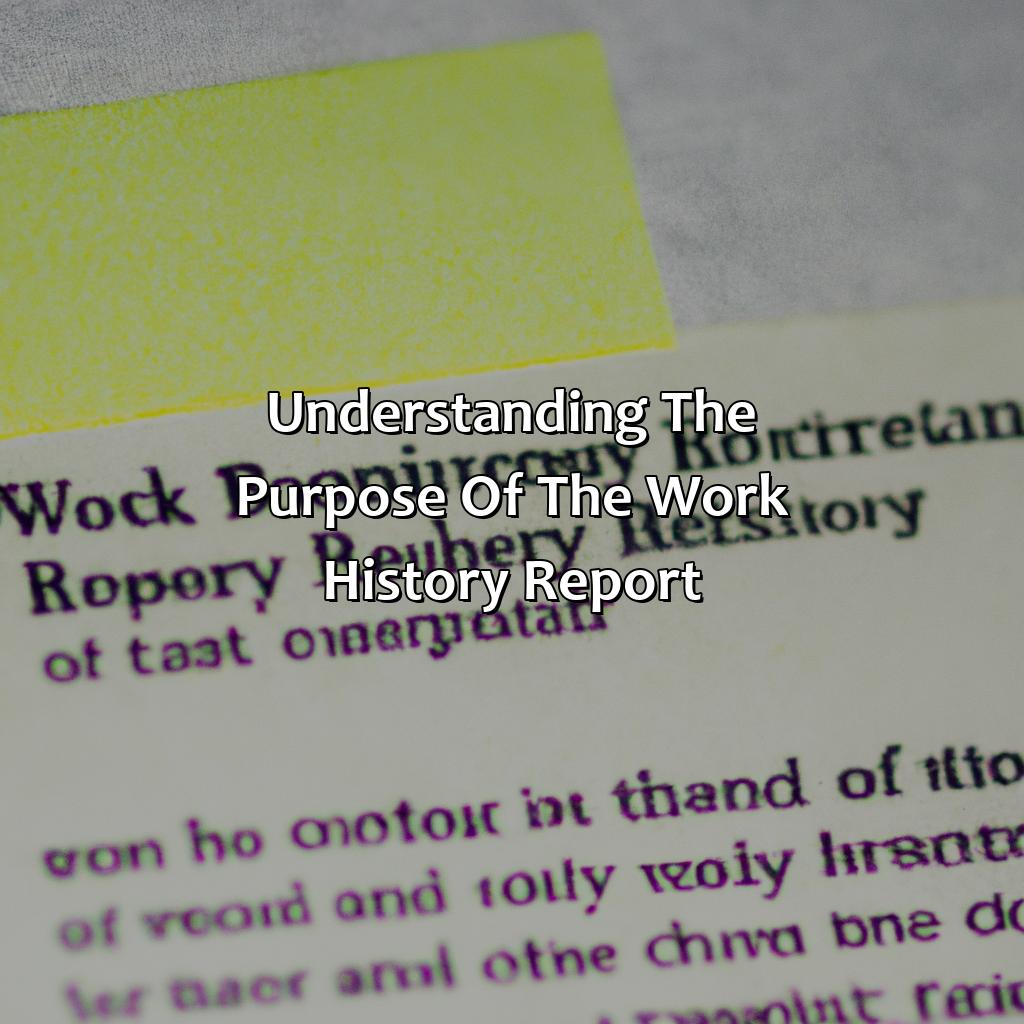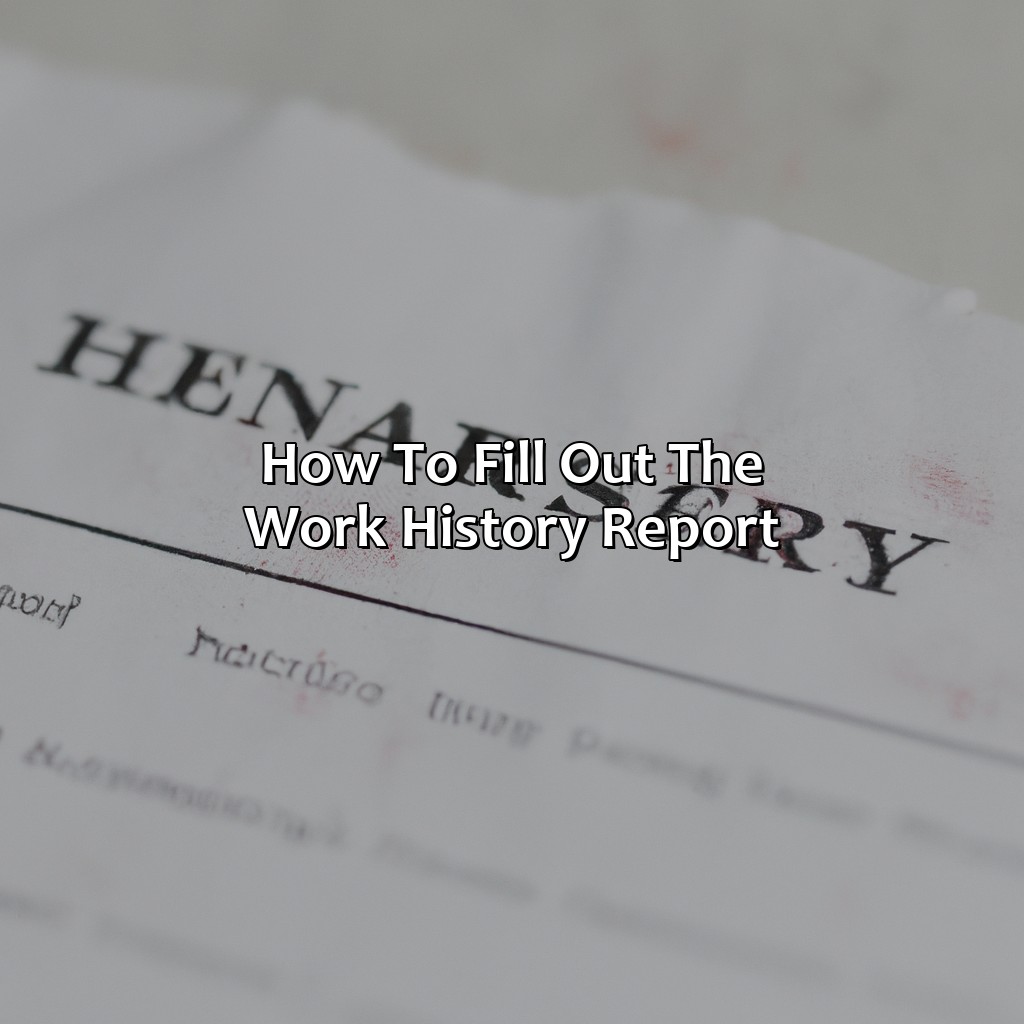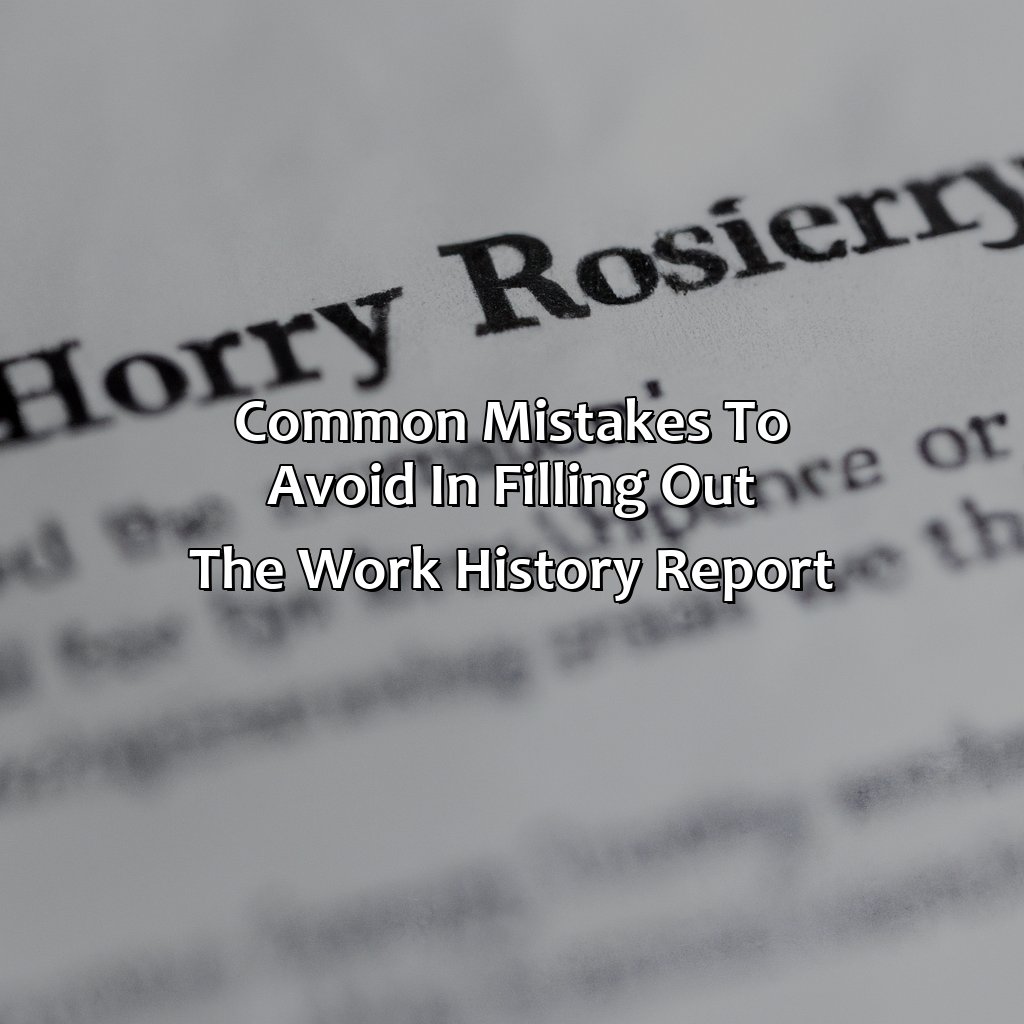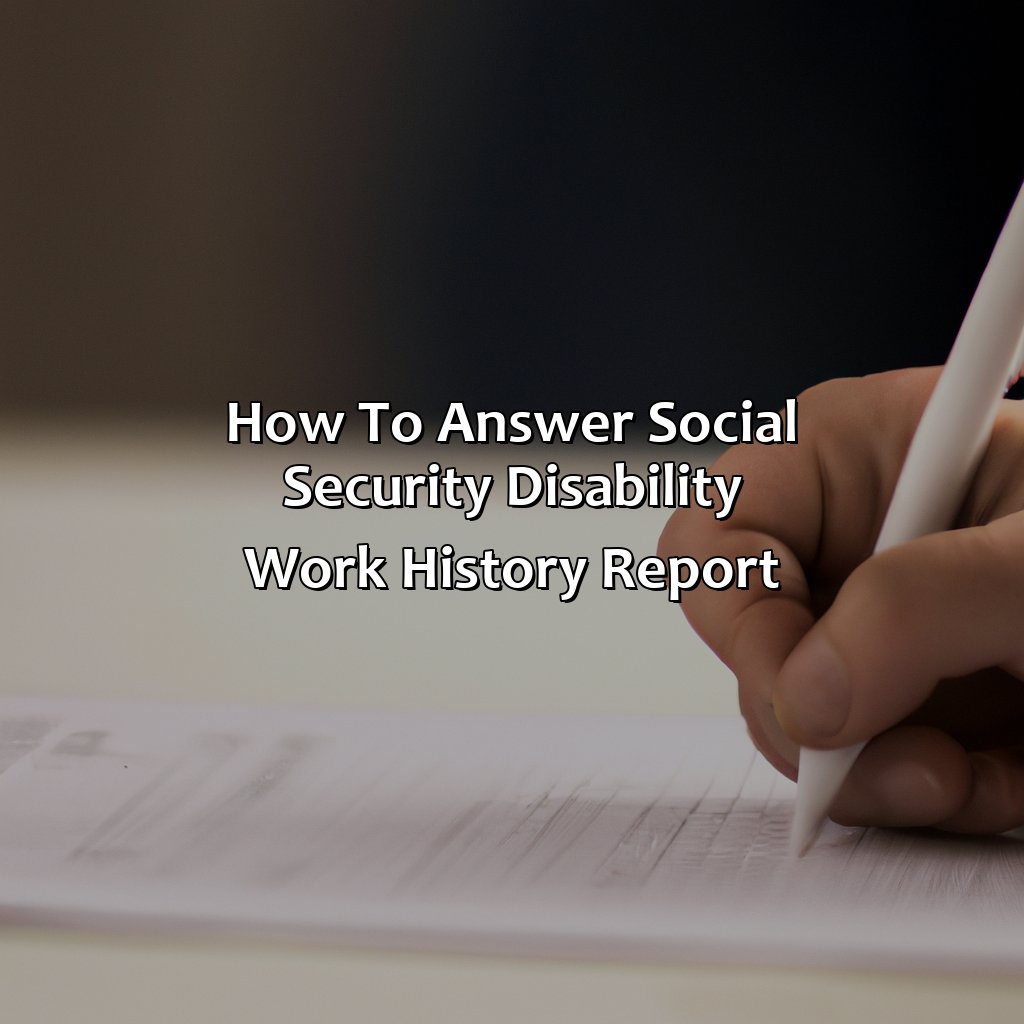How To Answer Social Security Disability Work History Report?
Key Takeaway:
- Understand the purpose of the work history report: The work history report is a crucial document that helps the Social Security Administration (SSA) assess your eligibility for disability benefits. It is important to understand the purpose and importance of each section of the report in order to fill it out accurately.
- Filling out the work history report: To fill out the work history report, gather all relevant employment information, provide accurate dates and job titles, and describe job duties and responsibilities in detail. It is important to be honest and accurate throughout the report.
- Seek professional help if needed: Filling out the work history report can be a complex process, and it is important to seek professional help from a disability attorney or advocate if needed. They can help ensure the accuracy of your report and increase your chances of a successful disability claim.
Are you struggling to answer the Social Security Disability Work History Report? You need to know the right information to provide as it can be critical for gaining approval. Don’t worry – this article will show you how to answer the form accurately.
Understanding the purpose of the work history report
The work history report is a critical document that is used to evaluate your eligibility for social security disability benefits. Its purpose is to provide detailed information regarding your past work activities, including dates of employment, job duties, and skills required. This information helps assess how your medical condition affects your ability to perform work-related tasks.
The work history report is an essential tool for the Social Security Administration (SSA) to evaluate your medical condition and its impact on your work capacity. It helps the SSA understand your job duties, working conditions, and skills required to perform your job. With this information, the SSA can determine whether you have the ability to perform other jobs that exist in the national economy.
Ensure that you provide accurate and complete information in the work history report. Avoid leaving any gaps in employment history and provide detailed information on job duties and skills required. Also, include information on any changes in job duties or accommodations made by your employer due to your medical condition.
Pro Tip: Seek professional assistance from a social security disability attorney to help you complete the work history report. They can ensure that all of your information is complete and accurate, increasing your chances of being approved for disability benefits.

Image credits: retiregenz.com by David Jones
How to fill out the work history report
Fill out that Social Security Disability report correctly! You’ll need employment info. Dates and job titles are key. Describe duties and responsibilities too. Here’s how to get your facts right: Gather the data, then fill in the blanks!

Image credits: retiregenz.com by Yuval Arnold
Gathering relevant employment information
In order to effectively complete the SS disability work history report, it is essential to collect pertinent details from previous employments. This step ensures that the correct information is included in the application form. Collect all significant employment-related information such as job titles, job description, and dates of employment.
Next, it’s important to list down all the companies you’ve worked for previously. Make sure you have accurate company names and addresses so that there are no delays in processing your application. Also, include any contact information for HR departments or supervisors that may be required.
To further supplement your employment history data, outline your job duties and responsibilities for each position held. Details like tasks performed daily or weekly can help establish how long you have been unable to perform substantial gainful activity (SGA) due to impairment.
Lastly, gather any additional evidence of your work history such as W-2 forms or paystubs from previous employers to validate your claims. Include specific dates and amounts paid for each period worked at a given employer when using financial paperwork as supporting documentation.
As you move through this process of collecting relevant information, it can be helpful to use an organizational tool such as a spreadsheet or template for better clarity. Doing so will spare yourself from having to make another request toward claim submission deadline made by Disability Determination Services (DDS).
Consider Frank’s story where he left out important details in his application because he failed to properly organize and obtain concrete data relating to his employment history; thus, he received a decision unfavorable towards compensation.
Getting your dates and job titles right on the work history report is like trying to solve a Rubik’s Cube blindfolded, but with more paperwork.
Providing accurate dates and job titles
It’s crucial to furnish precise dates and job titles while completing the work history report for social security disability. Inaccurate information can potentially affect the assessment of your eligibility for benefits.
As this report is one of the essential documents required to apply for social security disability, ensure that your employment records are correct.
When filling out this form, ensure you list every job you had in the past 15 years and give accurate dates of employment, including start and end dates. Moreover, it’s imperative to provide the correct job title in each employment period as it defines your position at a specific company.
Apart from listing dates and job titles, other components play an integral part. For Example, make sure you calculate earnings accurately and add another income source if you earned any. Furthermore, including detailed information about job duties would clarify how your condition affected your ability to perform tasks at work.
Not providing adequate details can delay or even reject your application for SSDI benefits, which would cause financial hardships later on. Therefore ensure accuracy while completing this form and double-check all information because submitting incorrect data has consequences.
Describing job duties and responsibilities may be boring, but just remember, accurate information is the key to a successful work history report.
Describing job duties and responsibilities
When completing the Work History Report, you may be required to provide a detailed description of your job duties and responsibilities. This section is crucial in determining if your condition affects your ability to work. Clearly articulate what tasks you performed and how they were accomplished.
Include specific examples and the requirements for each duty, such as physical demands or deadlines. Make sure to use action verbs when describing your tasks to demonstrate your level of involvement. Use appropriate terminology relevant to the particular job or industry.
It’s recommended that you obtain a copy of your job description from previous employers to ensure that every aspect is correctly listed in the report. Verifying this information can prevent any discrepancies that could negatively affect the processing of your disability claim.
By accurately describing your job duties and responsibilities, you increase the likelihood of obtaining Social Security disability benefits. This is critical in ensuring that you receive appropriate compensation for losses due to a medical condition preventing you from performing necessary work activities.
Remember, honesty is the best policy unless you’re filling out a work history report.
Common mistakes to avoid in filling out the work history report
Avoid Work History Report Errors
It’s crucial to avoid mistakes when filling out the work history report for Social Security Disability. Any errors can result in delays or denials in receiving benefits.
Common mistakes to avoid in completing the Social Security Disability work history report include:
- Not providing detailed job descriptions and responsibilities
- Leaving gaps in employment history
- Leaving out medical history or disability-related details that may affect ability to work
Ensure a successful application by avoiding work history report errors. Detail job descriptions and responsibilities, don’t leave gaps in employment history, and include relevant medical history or disability information.
I had a client who left significant gaps in his employment history on his work history report. This resulted in extended delays when applying for Social Security Disability benefits. It’s critical to include a complete employment history for a successful application.

Image credits: retiregenz.com by James Woodhock
Importance of seeking professional help in completing the report
Completing the work history report for social security disability benefits can be a daunting task. Seeking professional help is crucial in ensuring accuracy and completeness of the report. Professional help can provide guidance on what information is relevant, how to present it, and what to include or exclude. This can greatly improve the chances of approval.
In addition to guidance, professional assistance can also help prevent common mistakes that could lead to a denial of benefits. Errors such as omitting work history details, not explaining gaps in employment, or not providing enough information about previous jobs can negatively impact the application.
It is important to choose a qualified professional, such as a social security disability lawyer or an experienced disability representative, to assist in completing the work history report. These professionals are well-versed in the process and can provide invaluable assistance in navigating the complex and confusing requirements.
A true fact about the importance of seeking professional help in completing the work history report can be found in a survey conducted by the Social Security Administration. The survey found that claimants who had professional representation were approved at a higher rate than those who did not, with a difference of over 20%.

Image credits: retiregenz.com by Joel Duncun
Five Well-Known Facts About How To Answer Social Security Disability Work History Report:
Provide detailed and accurate information about your work history, including dates of employment, job duties, and reasons for leaving. (Source: Social Security Administration)
Make sure your medical records align with and support the information you provide on the work history report. (Source: Disability Benefits Help)
Use your own words to describe your work duties and avoid copying from job descriptions or manuals. (Source: Disability Secrets)
Include relevant information about any accommodations or modifications you received at work due to your disability. (Source: Disability Advisor)
Seek the assistance of an experienced disability attorney or advocate to help you fill out the work history report accurately and effectively. (Source: Allsup)
FAQs about How To Answer Social Security Disability Work History Report?
What is a Social Security Disability Work History Report?
A Social Security Disability Work History Report is a document that asks for information about your work history, including job titles, duties, and dates of employment. It is used by the Social Security Administration (SSA) to determine if you are eligible for disability benefits.
What should I include in my Work History Report?
You should include all of your past employment information, including the name and address of your employer, your job title, the dates you worked there, and a brief description of your duties. You should also include any periods of unemployment, or gaps in your work history.
How can I make sure my Work History Report is accurate?
Be sure to check your employment records and verify the dates you worked at each job. If you’re unsure of an exact date, estimate as closely as possible. You should also review the duties you performed at each job and make sure they are accurately reflected in your report.
What if I can’t remember all of my past jobs?
If you can’t remember all of your past jobs, do your best to provide as much information as you can. The SSA may be able to help you fill in any gaps in your work history by contacting your employers directly.
Do I need to provide my Work History Report for every job I’ve ever had?
No, you don’t need to provide your Work History Report for every job you’ve ever had. However, you should include any job you’ve held in the last 15 years, as well as any job that lasted for at least 3 months, regardless of how long ago it was.
When should I submit my Work History Report?
You should submit your Work History Report as soon as possible after you file your disability claim. This will help ensure that the SSA has all of the information they need to make a decision about your eligibility for benefits.
 Checkout this IRS Loophole
Checkout this IRS Loophole 
